(骑砍2)龙旗的历史原型与由来----看完后你还想当霸主么? (骑砍2龙旗任务过期了)
(骑砍2)龙旗的历史原型与由来----看完后你还想当霸主么? (骑砍2龙旗任务过期了)
Origins: Sarmatians, Alans, Parthians and Persians:
The draco Standard was originally developed by the cavalry peoples of the steppes, such as the Sarmatians and the Alans, but also by the Parthians and the Sassanid Persians. It may have been used primarily to determine the wind-direction for the horse archers. Arrian described it as a long sleeve, made by sewing pieces of dyed material together. This sleeve/tube hung limp when the rider was at rest, but on the move it flew like a serpent and whistled in the wind. The hollow head, in the form of a toothed dragon, was formed from metal and the wind passing through it would extend the cloth tube tail attached to the neck of the head. The draco was also used by the Dacians (or their allies) and no less than 20 of these are shown on Trajans Column. Other sources mention Parthian and Sassanid Persian dracos.
Not all such standards had dragon heads. The one below on the left from Trajans Column shows the tubular tail with streamers attached. The head looks more like a dog (with ears) than a dragon. The one beside it has a much more serpentine head, and has scalloped rings attached to the tail. Other standards had no heads at all, just the fabric tube, while some had heads looking like wolves or even fishes. These had protruding ears and fins. The images below show part of the Arch of Galerius with several dracos.
Sassanid Persian dracos main have been made of fabric only. From the Historia Augusta we learn that when Aurelianus had reconquered Palmyra (272 AD), amongst the treasure were Persian dragon-flags (Persici dracones)[1], which to me sounds like the standards were discussing here. What these draco may have looked like we can see below; on the extreme right is a 5th c. AD Coptic wall painting, showing the occupying Sassanid Persian forces carrying two dracos.
它兴起于帕提亚帝国、波斯帝国、阿兰人和萨尔马提亚人
“龙旗(The draco Standard)”的文化由大草原上的骑兵民族首创,并不断地发展下去,诸如萨尔马提亚、阿兰,以及帕提亚、萨珊王朝等族群都有过一定程度的参与。其主要用途在于为骑射手判断风向,阿兰人的描述是这样的:
它的外形像衣服的袖口,以染织的布料缝合而成。当骑兵原地待命时,这个类似衣袖的部位总是低垂着,但他们一有动作的话,龙旗便在风中发出阵阵嘶鸣声,如“吐出信子的腾蛇般舞动着身躯”。头部是铁质、空心的、露出牙齿的龙首,连接了布制的旗幅,如果风从龙头吹过,旗帜就会膨胀开来,从龙颈一直舒展到尾端。达契亚人与其盟友也使用过龙旗,在罗马皇帝图拉真的纪念碑(Trajans Column)上,至少有20个同类的部族亮出了这面旗帜。其余的资料则提及帕提亚与萨珊波斯的龙旗。
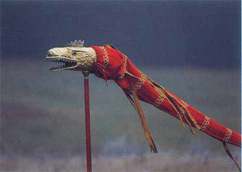
卡农图姆考古公园复原的龙旗
并不是所有的“龙旗”都安上了龙头,下面的这幅图取材于“图拉真圆柱(Trajans Column)“,它展示了一面以彩带依附在尾部的龙旗。旗帜的“龙首”顶着一双耳朵,看起来更像狗头而非是龙。
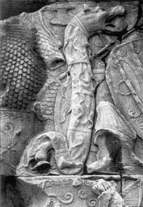
图拉真圆柱上的龙旗
再往下的又具备更加“蜿蜒匍匐”的“龙首”,末梢衔接了一枚扇贝状的尾尖。
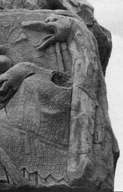
另一面龙旗
其他的龙旗甚至都没有龙首,只是一件件圆柱形的纺织品。有些则带着看上去像狼头,抑或是鱼头的“龙首”,这类龙旗长出了鳞片,伸长着一双双耳朵。接下来的图片向我们展示了“伽列里乌斯拱门(Arch of Galerius)”上的龙旗浮雕。
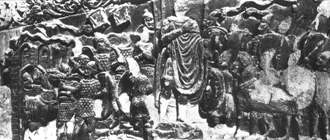
伽列里乌斯拱门上,皇帝身旁的士兵们携带了龙旗
大部分的萨珊波斯龙旗仅仅靠纺织品制成。由历史学家奥古斯塔的论著《Aurelianus》中28.4可知,奥勒里安努斯皇帝于公元272年再度征服帕尔米拉王国时,缴获的珍宝中就有“波斯龙旗(Persici dracones)”,这听起来很像本文所讨论的龙旗。此类龙旗的外观可以从下图中看到,它所代表的是5世纪的壁画,展现了萨珊王朝的军队占领帕尔米拉城后带着的两面龙旗。
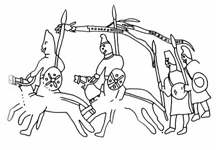
这是4-5世纪时,哥普特壁画的拓本,出自埃及的哈里杰绿洲,展示了萨珊帝国的龙旗
The Draco was adopted first into the Roman cavalry during the 2nd century AD, possibly with the introduction of Sarmatian cavalry into the Roman army. Arrian, who was writing c. 137 AD, described it as a Scythian (he most probably meant Sarmatian) invention which was adopted by Roman cavalry[2]. The Romans first began to use the draco in cavalry games, the so-called Hippica Gymnasia. These were described by Arrian as glamorised versions of training exercises, performed in decorated armour. It is possible that the draco was introduced just because it was outlandish, foreign and glamourous. Points in the game were scored for strikes on the tail piece of the dracos carried by a team acting as targets, from dummy javelins thrown by another team of riders. Arrian recommended that the standard be colorful, adding to to the spectacle of cavalry parades. One should be given to each unit to maintain order in both displays and battle. The Roman cavalry adopted the draco probably during or after the Dacian wars, in which the equipment of the Roman cavalry was altere to withstand the charged of the lance-armed cavalry. These equipment changes included the adoption of the fully-armed cavalry (alae cataphractiorum) and the long lance. It would be logical to assume that this was the time when also the draco standard was introduced.
罗马龙旗
公元2世纪左右,罗马帝国首次采用了龙旗作为军队的一大标志。很有可能是萨尔马提亚骑兵将其引入了罗马军团,创作了《c. 137 AD》一书的Arrian叙述道:它是塞西亚人(或萨尔马提亚)的发明,后来为罗马的骑兵部队所吸纳。罗马人起初把龙旗用在马术比赛Hippica Gymnasia上——顾名思义,它类似于中世纪的竞技大会,Arrian做出了如是描述:“用装饰盔甲来推演过程、经过点缀的练习赛,以这种形式来吸引群众的目光。”那么龙旗走进罗马的原因嘛,恐怕就出于它舶来品、有逼格、倍儿有范的特征了。比赛当中的部分队员扮演“靶方(targets)”,他们肩负着龙旗。对方的骑手丢出标枪时,只要击中了旗帜的尾尖,都会产生对应的得分。Arrian说,比赛通常与游行集会一同举办(很像今天的古战场复原活动);旗帜必须做到色彩丰富、且鲜艳,看上去非常显眼,如此一来,才能让赛场上的每个成员遵守规则,有条不紊地把表演进行下去。至于罗马人吸收龙旗文化的时间段,也许是在达西亚战争期间。面对以举枪冲锋与提枪捅杀的姿态发起攻势的骑手,为了能拒敌于千里之外,罗马骑兵正经历着一场巨变。部队的标配囊括了加长版的骑枪,他们的制式装备恰好朝着“早期具装骑兵(alae cataphractiorum) ”的方向发展。因而龙旗于同时期传入了罗马军队,这一点在逻辑上是说得通的。
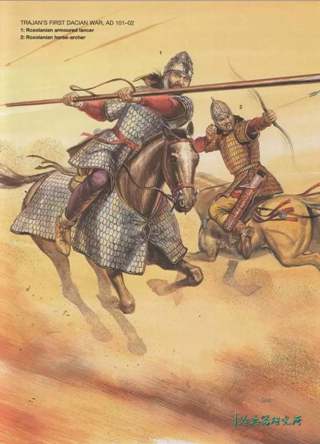
萨尔马提亚具装骑兵
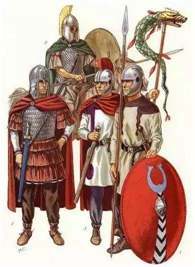
罗马人一直在学习游牧民族的军事制度,作为雇佣军的萨尔马提亚人也是效仿对象
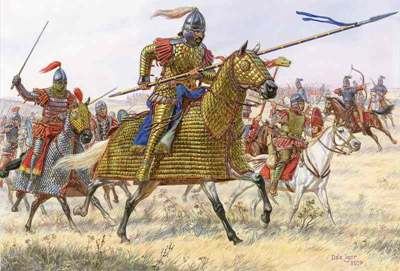
具装骑兵、东罗马骑射手和使用投矛的轻骑兵
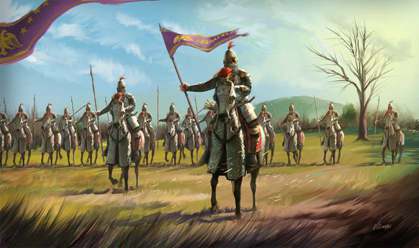
古典重骑兵通常会配备弓箭,龙旗很可能是跟随了这股趋势,才传入罗马军队的
那为什么有人专拣神龙或者巨蛇,以它们作为原型来改造和加工呢?由于草原文明的图腾常常把不同种类的兽首与蛇身结合,也总会将彼此相近的传统延续下去,这件事便很难解释得清楚。还有种说法作出了猜测,原因是色雷斯骑手对罗马军队的威慑力促使罗马人吸纳了巨蛇的纹章。前者非常尊崇某位女神,她类似于一只“飞龙在天”的腾蛇,生着一副利齿、逆鳞与高耸的背鳍(很贴近龙这类神话生物的形象了)。
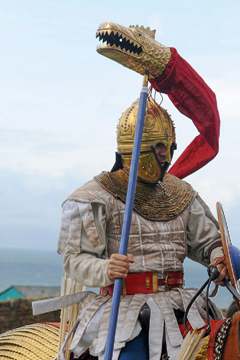
目前没有记录显示何年何月,龙旗变成了哪个兵种的军旗。但某些资料提到,一个国家的步兵使用过它。历史学家奥古斯塔曾言及公元193—211年在位的赛维鲁斯皇帝,他的母亲于分娩的前一晚梦见了紫色的腾蛇——与我们口耳相传的帝国龙旗非常相像。不过世面上也有观点认为这是后人编造的故事,我们不太确定那个解释是不是在牵强附会,却更依赖于板上钉钉的事实:据说伽利埃努斯皇帝统治时期(253-268),军团士兵会在游行时簇拥着龙旗,而它正是军团的一大象征。公元270—275年间治国的奥勒利乌斯皇帝也曾下令,让军团的掌旗官们在执持“双头鹰”的同时,亦要夹带着少量的龙旗。如此我们便能得出一个结论,那就是到了3世纪晚期,罗马的军团步兵已经开始使用龙旗了。公元311年前,人们为了纪念从290年起,伽列里乌斯皇帝与萨珊王朝的战争而建造了“伽列里乌斯拱门”。我们可以从上文中的图片看到:皇帝左右的步军和骑兵侍从都高举着龙旗)。
We have no good idea about the general appearance of the draco. Some draco heads may have looked like a draco, but some seem to look more like wolves or dogs, or even of an ass (..).
我们对龙旗的总体观感并不清晰,有些龙旗的头部看起来还有龙的样子,有些却很像狼、狗,甚至是驴子……
Also, we cant be sure of the lenght of the windsock, or the actual length of the pole on which it was carried.
我们也不确定风向袋与其内径的实际尺寸。
However, the coins of the Emperor Trajan Decius (AD 249-251) give us some idea as to tall the latter was. If not a representation of a boar-headed trumpet (carnycus), it does not seem to have been taller than a man. In my opinion though, the Emperor would rather be shown with an standard.
然而,我们可以通过德西乌斯时期(249-251) 的钱币来一探究竟。野猪头长号“carnycus”(一种形状与龙旗相似的古代乐器)没有出土的话,龙旗也许不会比人还高。依我看来,皇帝们更乐意在一面军旗之下亮相。
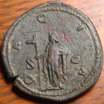
The draco in the Late Roman army
The late 4th c. author Vegetius also mentions the draco as a common standard. He seems to have been confused about the difference between the old standards and the new dragons though, as he wrote that apparently standard- and draco-bearers differ[6], but also that the standardbearers are now named dragonbearers[7], that both are present in a camp[8], but also that each cohort has a draco[9]. if correct it would mean the first overall standard for the cohort (where before none had existed between the legionary aquila and the signa of the centuries). the draco may have foreshadowed the later common practise in the 3rd century to permanently detach cohortes from their parent legions.
罗马帝国晚期的龙旗
四世纪末的作家韦格蒂乌斯曾经提起,龙旗在当时已然成为了军旗,于罗马军中普及了开来。但作为当事人的他也非常疑惑,对龙旗与旧式军旗之间的差异很是不解。他的著作中写到,二者所对应的旗手有着一些不同之处,掌旗官的称号又变成了“龙旗手(dragonbearers)”,而他们仍然并存于同一编制内。军团的每个大队(cohort)都配有一面龙旗,如果以上叙述属实,这就意味着龙旗是象征大队、乃至各类高级指挥官的“将旗”和“帅旗”(那也正是数个世纪前,罗马军团的鹰旗和掌旗官们所不具备的属性)。除了军团的常规编制外,龙旗很可能还昭示着“独立纵队(detach cohortes)”的诞生,它们在3世纪末的事迹可以说是不胜枚举了。
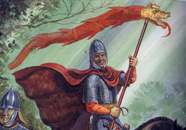
龙旗复原图
By the fifth century, as may be deduced from inscriptions from Perge and Prusias/�sk�b�, Turkey, as well as a poem by Prudentius, there was a rank called magister draconum. This officer was the superior of the draconarii in a unit, ranking immediately below the tribune. However, we dont know if he directed the draconarii in battle, or may just have been the head of the standard bearers club or scholae. The magister draconum probably replaced the optio signiferorum, whose function unfortunately is equally vague. Other ranks are less clear: from Cagliari/Sardinia we know an optio draconarius, while the bearcus draconarius seems to have been an unusually high-ranking draconarius.
Prudentius also tells us that Late Roman draconarii wore golden torcs as reward for their valor in battle. However, we learn from Ammianus that the torc may have been a badge of office, so possibly standard bearers were selected from those who had earlier received such torcs, marking them for an elite.
公元357年之前,君士坦丁和朱利安皇帝(他是由某个龙旗手加冕为王的)都有专门定制的龙旗,它们通常由紫色的面料织成。史学家阿米阿努斯·马尔切利的著作中如是讲述:战况焦灼之际,御用龙旗有着区分指挥级别的功能。它的主要作用在于协调战略与战术,而非单纯地崇拜个人。到了357年的斯特拉斯堡战役,朱利安的龙旗处于极其重要的位置,甚至帮助皇帝重获了战场的主导权。5世纪的著作家佐西默斯亦曾提及,萨珊军队缴获过一面龙旗,这惹得朱利安龙颜大怒,直气得他暴跳如雷。
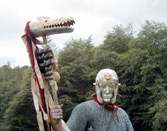
佩尔格人、土耳其、普鲁士人(?原文可能打错字了)留下的碑文与普鲁登蒂乌斯的诗篇同时印证了一点:直至公元5世纪,军团的编制有过“龙旗长(magister draconum)”一职。这类军官的地位仅次于担任参谋长的“护民官(tribune)”,在所有“龙旗手”当中,他的级别是最高的。但他是否会向其他龙旗手打出旗语,引导他们的指挥系统呢?这一点尚且存疑,也许龙旗长只不过是旗手们在军队中的代表吧。还有一种可能,龙旗长仅仅替代了传令官(optio),也就是之前提到的掌旗官的职能——不幸的是,史料上的种种记载总是模棱两可、含糊不清的。至于其他的龙旗手,他们的位置就更不明了了。从“Cagliar”和“Sardinia” 我们可以了解到一部分负责传令的龙旗手,其中Bearcus draconarius最为不同寻常,是地位较高的龙旗手。
普鲁登蒂乌斯的诗句也告诉了我们,罗马帝国晚期的龙旗手戴着一副金项圈,以示其作战勇猛而得到的表彰。我们从阿米安乌斯那儿领会到了用意所在——这种项圈常常带有“铭牌”,说明旗手们可能会从受到嘉奖的士兵中千挑万选,通过授予这些徽章,来凸显他们作为百战菁英的特殊身份。
The East Roman or Byzantine draconarius
Around the mid-6th century, the historian Johannes Lydos mentioned the draconarius (drakonarioi-drakontophoroi) in a list of ranks and functions[15]. Justinian also mentioned a corps of 10 draconarii in his edict of 534, issued to Belisarius in North Africa[16]. The military manual called the Strategikon of the emperor Maurikios (582-602 AD) shows that draconarii were probably still around in the early 7th. century. However, it is not clear whether the draconarius mentioned there [17] was already anachronistic or if he still had a proper military function - there was a scholae draconariorum, a non-military office staff of 10 clercs attached to a civilian praefectus praetorio. After the 6th century, the draconarius disappeared from the Byzantine army.
东罗马、亦即拜占庭帝国的“鱼龙旗手”
历史学家约翰尼斯·列都斯大约在6世纪中叶陈述道,“鱼龙旗手”有着严格的等级划分,可以列出一长串排序。查士丁尼一世也说过:名将贝利撒留乌斯远征北非时,曾在534人的亲卫中,选拔出了10人组成的死士与“选锋”,而这些人个个都是骁勇善战的龙旗手。名为《领军学》(strategikon)的拜占庭军事教材显示,直至7世纪早期,龙旗手制度依然存在。但它后来是否被摒弃了,并且不再履行军队职能了呢?对此我们也不甚明了——我们只能看到一支10人之众的小型卫队“scholae draconariorum”,它直属于平民出身的禁卫军统帅。公元7世纪之后,龙旗手便从拜占庭军队中彻底消失了。
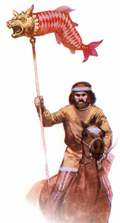
帕提亚人的“鱼龙旗”
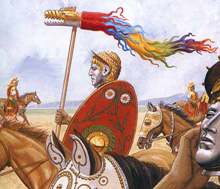
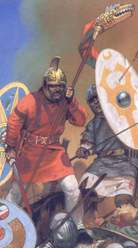
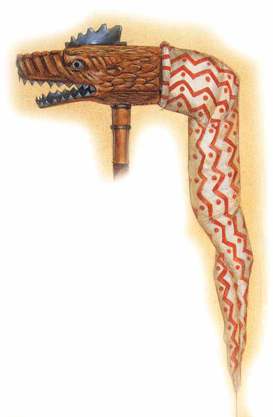
After the Romans
Dracos continued in use in the Caucasus and Georgia, while in the West the Franks under Charlemagne may have adopted them again. This may show continuity, or else Charlemagnes attempts to eminate the Roman Army. We have a miniature from the late 9th-c. Psalterium Aureum (MS St. Gall. Stift-Bib. 22, fol. 140, illustrating Psalm 59), which shows a draco in a formation of heavy cavalry.
We also see it used at the battle of Hastings in 1066 AD, where it is carried by Harold Godwinsons retainer at the moment of his death.
The next image is from a 14th-century manuscript of LHistoire de Merlin by Robert de Boron, now in the Bibliotheque Nationale in Paris. It shows King Arthur in combat, brandishing what can only be a Medieval representation of a Late Roman draco. This is not supposed to reflect 14th-c. battle standards, but rather a fanciful idea of ancient use.
The last image shows the flag of modern Wales, in Welsh called Y Draig Goch (The Red Dragon). This red dragon, as the tale goes, would go back to the myth of the red and white dragons fighting on Vortigerns fort at Dinas Emrys in Gwynedd, Wales. These dragons, though, are thought by some to represent the draco of the Late Roman army.
The Dragon of Wessex, like the Red Dragon of Wales, may indeed represent some form of continuity. However, it could also show Francish influence in England and Wales during the early Middle Ages, as well as an antiquity-related Romanticism which has nothing to do with reality any more.
罗马灭亡后
在格鲁吉亚和高加索等地区,龙旗被沿用了下来,西欧国家也融入了这个文化——为了效仿罗马的旧制,法兰克国王查理曼再度启用了龙旗。我们有一份19世纪末的手抄本Psalterium Aureum (MS St. Gall. Stift-Bib. 22, fol. 140, illustrating Psalm 59),其中的插图展示了重骑兵方阵里的龙旗。我们还可以看到,1066年的黑斯廷斯战役曾有过龙旗的踪迹。哈罗德·葛温森兵败身死之时,他的仆从正扛着这面旗帜。
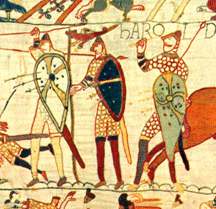
黑斯廷斯战场上的“韦塞克斯龙旗”
接下来的这幅图出自14世纪的手稿《LHistoire de Merlin》,由Robert de Boron创作,现存于法国国家图书馆。那是交战中的亚瑟王正挥舞着龙旗——以中世纪龙的形式来表现罗马帝国末期的龙旗。那么龙旗算是14世纪的军旗了吧?这种说法纯粹就是在异想天开了!我们不能轻易地下定结论。
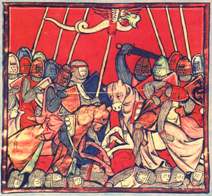
亚瑟王的龙旗
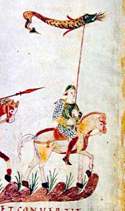
法兰克军队的龙旗

威尔士公国旗帜——可追溯到亚瑟王,乃至古罗马时代
最后一张图片中的是现代威尔士公国的龙纹旗,当地人称它为Y Draig Goch(红龙)。那里存在一个民间传说:红龙会回归圭内斯郡,在Dinas Emrys山中的伏提庚堡垒里,与白龙继续搏斗下去。尽管如此,仍有些人认为红龙的纹章象征着罗马军团的龙旗。
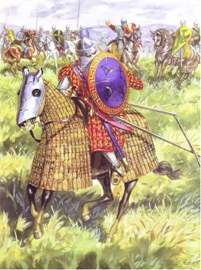
弓马娴熟的拜占庭骑兵也抛弃了“祖宗之法”,不再注重骑射,转而向西欧骑士们学习
韦塞克斯之龙、威尔士的龙纹或许是种精神的传承,也透露出中世纪早期的法兰克文化对英格兰和威尔士的影响,还通过对古典文明的描摹,抒发了人们内心深处的浪漫主义情怀——但它本身却与中古欧洲的军事传统并无关联,也不再具有实用性了。
以上就是((骑砍2)龙旗的历史原型与由来----看完后你还想当霸主么? (骑砍2龙旗任务过期了))全部内容,收藏起来下次访问不迷路!
